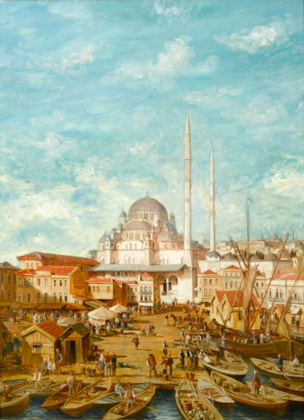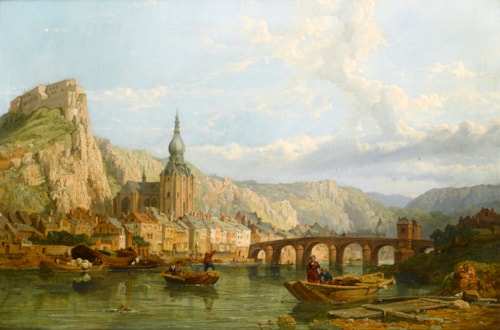ussian School, Twentieth Century
The All-Russian Exhibition centre, Moscow
oil on canvas
69.5 x 59.5 cm (27¼ x 23½ in)
The All-Russian Exhibition Centre (VVTs), formerly The Exhibition of Economic Achievements (VDNKh), has been the site of some of the largest and most elaborate agricultural, industrial, social and scientific exhibitions in Russia in the twentieth century. Established in 1935, it opened on 1st August 1939 with the inaugural All-Union Exhibition of Agriculture. The complex was formed of a series of pavilions, totalling more than eighty by 1989, each dedicated to a particular industry or economic achievement. The total site today, complete with its fountains, parks and numerous other monuments, spans an incredible 2.4 million square metres.
The present painting is a view from the back of what is now known as the Aerospace Pavilion at the All Russian Exhibition Centre. Commanding the centre of the painting, the darkened palette of the pavilion’s graceful dome is mirrored in the stormy overcast sky. Originally known as the Mechanisation Pavilion, the structure was designed by the architects V.S. Andreev and I.G. Tarakanov, and built for the inaugural All-Union Agricultural Exhibition in 1939. The main structure, which overlooked Mechanisation Square, consisted of a large hangar in which state-of-the-art agricultural machinery was displayed on constantly-moving conveyor belts over two levels, creating an ‘imposing picture of the industrial strength of the USSR’s agriculture.’
Following World War II, the pavilion was renamed the ‘Mechanisation and Electrification of Agriculture’, and grew significantly to encompass the two-storey cupola hall - the height of the glass cupola with metallic framework being a staggering sixty meters. The main façade was flanked with towers crowned by sculptures of a worker and a female farmer, and the towers themselves were covered with bas-reliefs devoted to the mechanisation and electrification of agriculture. From 1964, the pavilion became known as the Aerospace Pavilion and during the 1960s housed a hugely popular exhibition devoted to cosmonautical paraphernalia and the astronaut Yury Gagarin (1934-1968).
To the left is Pavilion 51, The Glavmyaso Pavilion, crowned with the sculpture of a Giant Bull. Built for the All-Union Agricultural Exhibition of 1954 by the architects V. M. Lisitsyn and S. G. Chernobay, it eventually became known as the Meat Industry Pavilion. In front of these magnificent structures is a lake, upon whose surface the dominating dome of the Mechanisation Pavillion is reflected. In the near left hand corner, stands the Zolotoi Kolos fountain. A giant ear of wheat, glittering with gold mosaics, emerges from the water; the wheat motif was frequently repeated throughout the park’s decorative scheme and symbolised agricultural production.
The All-Russian Exhibition Centre (VVTs), formerly The Exhibition of Economic Achievements (VDNKh), has been the site of some of the largest and most elaborate agricultural, industrial, social and scientific exhibitions in Russia in the twentieth century. Established in 1935, it opened on 1st August 1939 with the inaugural All-Union Exhibition of Agriculture. The complex was formed of a series of pavilions, totalling more than eighty by 1989, each dedicated to a particular industry or economic achievement. The total site today, complete with its fountains, parks and numerous other monuments, spans an incredible 2.4 million square metres.
The present painting is a view from the back of what is now known as the Aerospace Pavilion at the All Russian Exhibition Centre. Commanding the centre of the painting, the darkened palette of the pavilion’s graceful dome is mirrored in the stormy overcast sky. Originally known as the Mechanisation Pavilion, the structure was designed by the architects V.S. Andreev and I.G. Tarakanov, and built for the inaugural All-Union Agricultural Exhibition in 1939. The main structure, which overlooked Mechanisation Square, consisted of a large hangar in which state-of-the-art agricultural machinery was displayed on constantly-moving conveyor belts over two levels, creating an ‘imposing picture of the industrial strength of the USSR’s agriculture.’
Following World War II, the pavilion was renamed the ‘Mechanisation and Electrification of Agriculture’, and grew significantly to encompass the two-storey cupola hall - the height of the glass cupola with metallic framework being a staggering sixty meters. The main façade was flanked with towers crowned by sculptures of a worker and a female farmer, and the towers themselves were covered with bas-reliefs devoted to the mechanisation and electrification of agriculture. From 1964, the pavilion became known as the Aerospace Pavilion and during the 1960s housed a hugely popular exhibition devoted to cosmonautical paraphernalia and the astronaut Yury Gagarin (1934-1968).
To the left is Pavilion 51, The Glavmyaso Pavilion, crowned with the sculpture of a Giant Bull. Built for the All-Union Agricultural Exhibition of 1954 by the architects V. M. Lisitsyn and S. G. Chernobay, it eventually became known as the Meat Industry Pavilion. In front of these magnificent structures is a lake, upon whose surface the dominating dome of the Mechanisation Pavillion is reflected. In the near left hand corner, stands the Zolotoi Kolos fountain. A giant ear of wheat, glittering with gold mosaics, emerges from the water; the wheat motif was frequently repeated throughout the park’s decorative scheme and symbolised agricultural production.





 contact
contact contact
contact +44 20 7313 8040
+44 20 7313 8040









